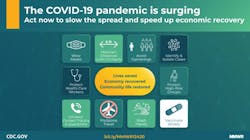CDC provides guidance on strategies to address SARS-CoV-2 community transmission, related deaths
The Centers for Disease Control and Prevention (CDC) announced new guidance that highlights critical evidence-based CDC recommendations and sustainable strategies to reduce COVID-19 transmission.
In the 10 months since the first confirmed case of COVID-19 was reported in the United States on Jan. 20, 2020, approximately 13.8 million cases and 272,525 deaths have been reported in the United States. On October 30, the number of new cases reported in the United States in a single day exceeded 100,000 for the first time, and by December 2 had reached a daily high of 196,227.
The COVID-19 pandemic control requires a multipronged application of evidence-based strategies while improving health equity: universal face mask use, physical distancing, avoiding nonessential indoor spaces, increasing testing, prompt quarantine of exposed persons, safeguarding those at increased risk for severe illness or death, protecting essential workers, postponing travel, enhancing ventilation and hand hygiene, and achieving widespread COVID-19 vaccination coverage. These combined strategies will protect healthcare, essential businesses, and schools, bridging to a future with high community coverage of effective vaccines and safe return to more activities in a range of settings.
With colder weather, more time spent indoors, the ongoing U.S. holiday season, and silent spread of disease, with approximately 50 percent of transmission from asymptomatic persons, the United States has entered a phase of high-level transmission where a multipronged approach to implementing all evidence-based public health strategies at both the individual and community levels is essential.
These strategies include 1) universal face mask use, 2) maintaining physical distance from other persons and limiting in-person contacts, 3) avoiding nonessential indoor spaces and crowded outdoor spaces, 4) increasing testing to rapidly identify and isolate infected persons, 5) promptly identifying, quarantining, and testing close contacts of persons with known COVID-19, 6) safeguarding persons most at risk for severe illness or death from infection with SARS-CoV-2, the virus that causes COVID-19, 7) protecting essential workers with provision of adequate personal protective equipment and safe work practices, 8) postponing travel, 9) increasing room air ventilation and enhancing hand hygiene and environmental disinfection, and 10) achieving widespread availability and high community coverage with effective COVID-19 vaccines.
In combination, these strategies can reduce SARS-CoV-2 transmission, long-term sequelae or disability, and death, and mitigate the pandemic’s economic impact. Consistent implementation of these strategies improves health equity, preserves health care capacity, maintains the function of essential businesses, and supports the availability of in-person instruction for kindergarten through grade 12 schools and preschool. Individual persons, households, and communities should take these actions now to reduce SARS-CoV-2 transmission from its current high level. These actions will provide a bridge to a future with wide availability and high community coverage of effective vaccines, when safe return to more everyday activities in a range of settings will be possible.
